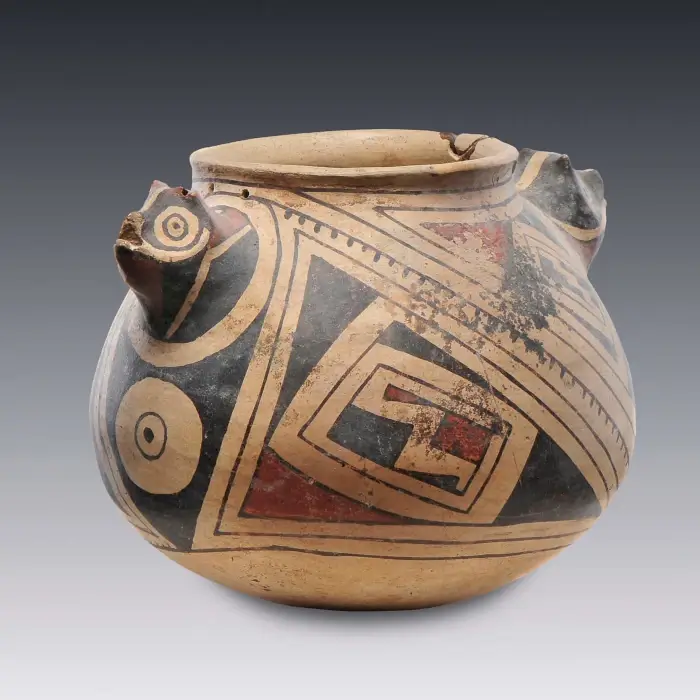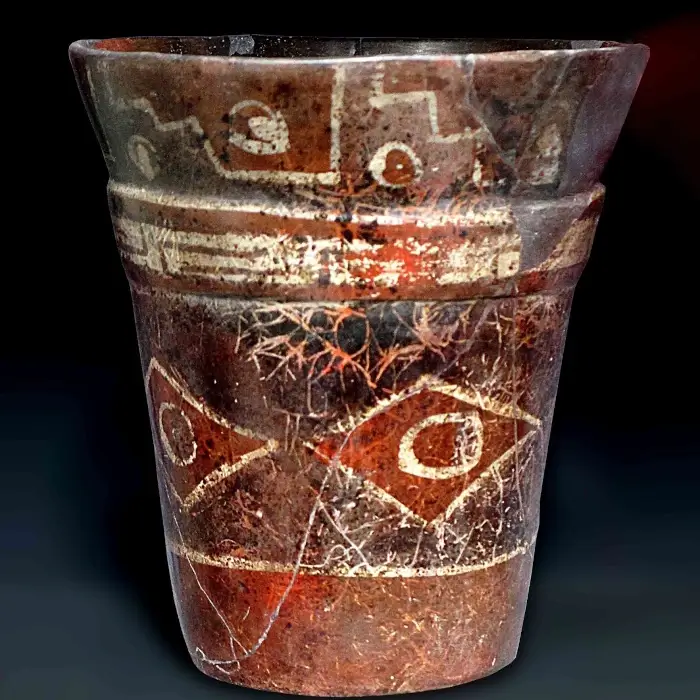Paracas Ceramics: Pre-Columbian Art and Tradition
Paracas pottery is an artistic manifestation of pre-Columbian art, originating from the Paracas culture, which flourished on the southern coast of present-day Peru between 700 BC and 200 AD.
Characterized by its exceptional technique, use of vivid colors and varied themes, this form of pottery reflects not only the skill of its artisans but also a profound religious and social worldview.

What is the origin of Paracas Ceramics?
Paracas pottery was born more than 2,700 years ago in the Andean culture that gives it its name.
Although textile production was remarkable in this society of southern pre-Columbian America, its pottery is also remarkable, evolving in two distinct periods:
During the Cavernas period (700 B.C. – 200 B.C.), ceramics had globular shapes and decorations that included motifs from the Chavín culture, with polychrome pieces made using post-firing techniques.
On the other hand, in the Necropolis period (200 BC – 200 AD), ceramics tended to be simpler, with ovoid shapes and less elaborate decorations, characterized by being monochrome.
Here’s how this art form was made and in what forms. Learn more about this mirror to the past, revealing the roots and evolutionary journey of one of the most enigmatic pre-Columbian cultures of the American continent.
Characteristics of Paracas ceramics
The alchemy of Paracas ceramics transcends the simple manipulation of mud and clay. Through a meticulous process, Paracas artisans molded pieces that would later be decorated with paints before being fired, a technique distinguished by the brilliant finish given to each piece.
They often employed the technique of molding and hand modeling to create complex shapes and detailed figures.
A notable aspect of Paracas pottery is its colorfulness. Unlike other pre-Columbian cultures that used a more limited palette, the Paracas achieved a wide range of colors through the use of minerals and specialized firing techniques.
Their vibrant colors make these pieces particularly eye-catching.
Which pieces of Paracas pottery were most frequent?
This pre-Columbian ceramic is characterized by its characteristic shapes and designs, among which are included:
Pitchers: Vessels with a narrow base and a globular body that widens towards the top. Frequently, these pitchers have elongated handles and necks, and are usually decorated with geometric motifs, animals and stylized human figures.
Bridge-handle bottles: A distinctive type of Paracas pottery, these bottles feature a handle that connects the neck to the body of the vessel, forming a bridge of sorts. These pieces often bear complex decorations that may include mythological beings, animals and abstract designs.
Bowls and Dishes: These pieces usually have a flat base with rounded edges and are less common than bridge-asa bottles. Bowls and plates also feature decorations, although they tend to be simpler compared to bottles.
Funerary Urns: Paracas funerary urns were used for burial rituals and often contained human remains and offerings. These urns could be elaborately decorated and reflect beliefs and funerary practices of the Paracas culture.
Figurines: Although not as common as vessels, ceramic figurines are also part of the Paracas artistic repertoire. These pieces often represent human figures or divinities and may have had a ritual or ceremonial purpose.

Buy pre-Columbian ceramics
Find original pieces and also reproductions identical to the traditional ceramic works that were made in pre-Columbian America and that are only found in museums, making them affordable.
Among its most emblematic pieces are also the sculpture-bottles in the shape of human heads, known as ‘cabeza-clavas’, and the huacos retablo, which are vessels decorated with complicated geometric designs and mythological figures.
Decorative motifs often included representations of local fauna, human figures in ceremonial activities, and complex geometric designs. These representations were not merely decorative; they carried a deep symbolism related to their religion and mythology.
The legacy of Paracas pottery
Beyond its undeniable beauty, each piece of Paracas handicraft is a testimony of the beliefs, rituals and social structure of this culture. Through their representations, it is possible to delve into the Paracas cosmovision, where the cult of natural deities and ancestors played a predominant role.
The precision and creativity of these artists not only influenced neighboring cultures, but have also captivated archaeologists, historians and art lovers for generations.
Today, the study of Paracas ceramics contributes to our understanding of the pre-Columbian past of the American continent and demonstrates the innate human capacity for artistic and symbolic expression.
The scenes detailed in these pre-Columbian artworks also give us a glimpse into the roles within Paracas society, from the social hierarchy and division of labor to the importance of ceremonies and rituals.





